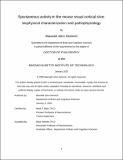Spontaneous activity in the mouse visual cortical slice: biophysical characterization and pathophysiology
Author(s)
Heinrich, Maxwell John
DownloadThesis PDF (3.001Mb)
Advisor
Bear, Mark F.
Terms of use
Metadata
Show full item recordAbstract
As we continue to await the first disease-modifying treatment for Fragile X Syndrome (FXS), the leading inherited cause of intellectual disability, the search continues for novel ways to address the core pathophysiology of this neurodevelopmental disorder. FXS is caused by silencing of the FMR1 gene, which results in the loss of fragile X messenger ribonucleoprotein (FMRP), a critical protein in regulating nervous system development and neural circuit function. Due to the loss of FMRP’s canonical role in inhibiting mRNA translation, an elevated rate of protein synthesis is widely recognized as a core feature of FXS pathophysiology. In this thesis, I present my investigation of a relatively understudied form of pathophysiology that arises in brain slices prepared from a mouse model of FXS, the Fmr1-knockout (KO) mouse. Relative to wildtype (WT) slices, Fmr1-KO visual cortical slices exhibit increased spiking activity in layer 5. Critically, this hyperactivity phenotype is rapidly reversed not only by treatments known to restore elevated rates of protein synthesis to WT levels, but also by the protein synthesis inhibitor cycloheximide. Therefore, rapidly turned over pathogenic proteins are suspected to actively maintain this form of pathophysiology. Identifying these pathogenic proteins could reveal novel therapeutic targets for the treatment of FXS. Progress requires a deeper understanding not only of the cellular pathophysiology supporting this hyperactivity, but also of the biophysical mechanisms driving the activity itself, as each remains relatively unexplored. In Chapter 1, I review relevant FXS pathophysiology and our understanding of the various forms of spontaneous activity generation in neocortical brain slices. In Chapter 2, I dive into the biophysical mechanisms underlying the sparse, spontaneous spiking activity generated in WT visual cortical slices. Here, I find extreme sensitivity to the ionic composition of the artificial cerebral spinal fluid (aCSF) bathing the slices. Lower, more physiologic concentrations of extracellular divalent cations render extratelencephalic layer 5 pyramidal neurons intrinsically active by altering the activity of the persistent sodium current. In Chapter 3, I detail my journey investigating the pathophysiology underlying the hyperactivity phenotype in Fmr1-KO mice. While my early investigations indicated that depolarized intratelencephalic layer 5 pyramidal neurons drive hyperactivity of the layer 5 circuit, this intracellular phenotype proved to be ephemeral and likely due to suboptimal slice conditions. Informed by the investigations of Chapter 2, I conclude that the hyperactivity phenotype is not driven by cell-intrinsic hyperexcitability of layer 5 pyramidal neurons. My optimization of slice conditions preserves the hyperactivity phenotype, setting the stage for future intracellular investigation of the cause of this pathophysiology. In Chapter 4, I describe the implications of my work for understanding activity generation in neocortex and provide direction for future studies of spontaneous activity in WT and Fmr1-KO visual cortical slices.
Date issued
2025-02Department
Massachusetts Institute of Technology. Department of Brain and Cognitive SciencesPublisher
Massachusetts Institute of Technology